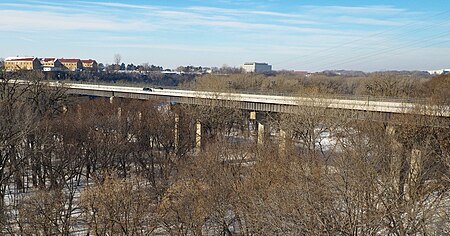Fort Road Bridge
1880 establishments in MinnesotaBridges completed in 1880Bridges completed in 1912Bridges completed in 1961Bridges in Saint Paul, Minnesota ... and 7 more
Bridges over the Mississippi RiverGirder bridges in the United StatesMidwestern United States bridge (structure) stubsMinnesota building and structure stubsMinnesota transportation stubsMississippi GorgeRoad bridges in Minnesota

Fort Road Bridge is a girder bridge that spans the Mississippi River between Saint Paul, and Fort Snelling, Minnesota, United States. It was built in 1960 by the Minnesota Department of Transportation and was designed by Sverdrup & Parcel Engineering Company. It is the third bridge on the site. The first bridge, a deck girder bridge, was built in 1880. The second bridge, a metal arch bridge, was built by 1912.
Excerpt from the Wikipedia article Fort Road Bridge (License: CC BY-SA 3.0, Authors, Images).Fort Road Bridge
MN 5, Saint Paul Highland
Geographical coordinates (GPS) Address Nearby Places Show on map
Geographical coordinates (GPS)
| Latitude | Longitude |
|---|---|
| N 44.894722222222 ° | E -93.181388888889 ° |
Address
Fort Road Bridge
MN 5
55116 Saint Paul, Highland
Minnesota, United States
Open on Google Maps










